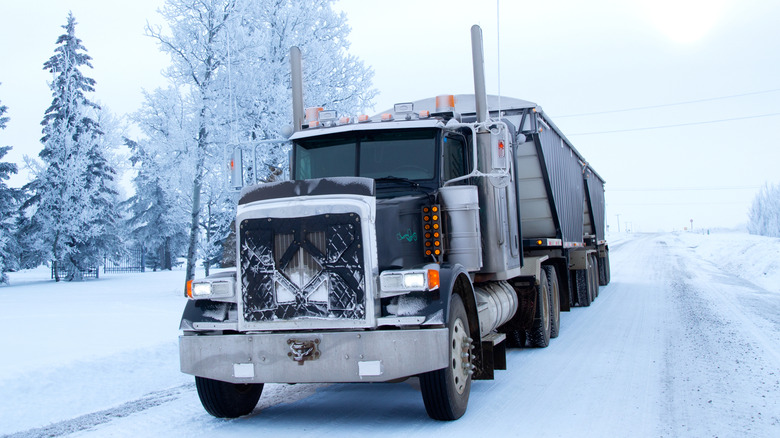Why Do Semi-Trucks Cover Their Grilles In Winter?
Over the years, semi-trucks have evolved to be able to take on any and all kinds of weather conditions. Given the crucial role these massive machines play in society for delivery and transporting goods, it's of great importance that they can hit the road no matter the time of year. You may have even seen a semi-truck barreling down the highway in the midst of a winter snowstorm. While there's always the potential of a dangerous situation occurring during such conditions, there are tools that can greatly aid in maintaining their functionality. Among these is a unique covering on a semi's grille that, while a seemingly small addition, plays a big role in keeping a truck running efficiently.
Commonly referred to as winterfronts, these covers are made to fit over the grille of a truck and can be found in a wide array of materials and styles. These range from quilted fabric options that can be zipped up in different directions to varying vinyl snap-on models to ultra-durable metallic covers. No matter the look, they play an equally important part in maintaining a semi-truck's overall functionality when it snows.
While the grille of a semi is designed to draw in cool air to keep the engine working properly, overly frigid temperatures can do more harm than good, which is especially the case for diesel engines. A winterfront guard helps better control the amount of air coming in while holding in some warmth, preventing harmful temperature imbalances and improving fuel economy as the engine doesn't have to work as hard.
Winterfronts can benefit drivers as well
As well as aiding in keeping the semi-truck itself up and running during periods of snowfall, winterfronts also prove beneficial to the drivers operating them. It's safe to say that investing in a winterfront is worthwhile for the money saved in the long run that would otherwise go towards fixing a malfunctioning engine or making frequent gas station stops, no matter how powerful the truck may be. But just as they do for semis, winterfronts do a lot to help keep drivers comfortable as well.
One of the most frustrating aspects truck drivers must deal with in the winter is the time it takes for their vehicles to warm up. The fact is that their great size and unique manner of starting up, particularly for diesel engines, means that semi-trucks take extra time to get to a comfortable temperature. This means drivers have to either give extra time for their trucks to warm up, which can eat into a driver's schedule, or take an extra uncomfortable ride in a truck that may not be all that efficient on the road.
Winterfronts can greatly cut down on this dilemma. By protecting the engine from excess cold, the engine can heat up more efficiently and prevent unnecessary delays. Likewise, it will better aid in maintaining warmth within the cabin, allowing for a more comfortable ride, especially if the driver needs to traverse long distances.

